Review and Onsite Photos by Rick Russack,
Catalog Photos Courtesy Thomaston Place Auction Galleries
THOMASTON, MAINE — Kaja Veilleux of Thomaston Place Auction Galleries put together a good variety of material for his November 14–15 auction. It grossed close to $1.4 million, with strong interest in several categories, including fine art, books, Native American, tall case clocks, good jewelry, furniture and an outstanding collection of Asian snuff bottles that drew bids from numerous foreign buyers. There were some surprises and some good buys for those in attendance. Numerous absentee bids were noted, and the sale had active Internet bidding on three platforms, as well as several phone lines in use.
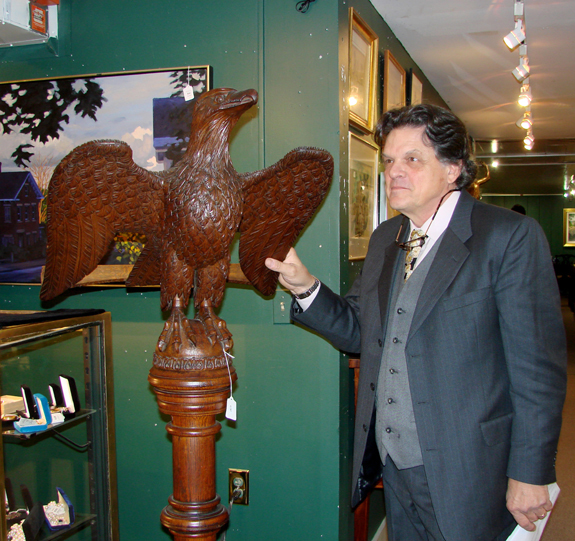
When asked what was his favorite item in the sale, Kaja Veilleux said it would be hard to pick just one item, but that he really liked the carved oak lectern with the outstretched wings.
The snuff bottle collection had been assembled over a number of years by a gentleman from Connecticut. More than 120 bottles of various materials were divided into 33 lots. There were several made of jade, along with porcelain, overlay and other glass, carved stone, rock crystal and agate. The collection grossed $124,165. Veilleux told Antiques and The Arts Weekly that he asked the collector to assist with the lotting and descriptions.
Leading the collection was a lot of two porcelain snuff bottles, including an iron-red and grisaille porcelain one with a mark dating it to the Daoguang period (1821–1850) and one of famille rose with a mark dating it to Qianlong (1736–1795). The two sold for $10,925. A group of five inside-painted Twentieth Century glass bottles was not far behind, earning $10,350. Several lots of Nineteenth Century overlay-glass bottles, also known as Peking glass, did quite well, with one lot of four bringing $8,625 and another lot of four finishing at $7,475. The collection averaged about $1,035 per bottle.
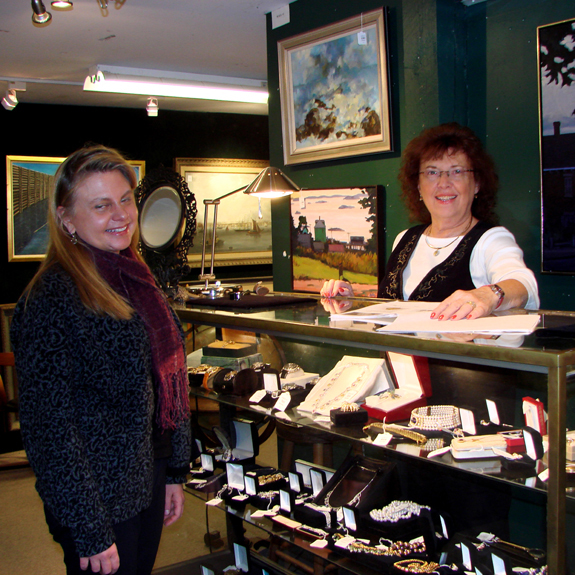
There were always people around the jewelry show case prior to the sale and the buyers liked what they saw.
Other Asian material also did well, with a porcelain meiping vase, Daoguang period, with paneled foot and shoulder finishing at $18,400 and a huge silk tapestry with raised silver and gold bullion selling for $9,200. It measured more than 92 by 54 inches and showed dragons emerging from the ocean. A Nineteenth Century copy of a Zhou dynasty bronze mirror holder, dating back to 1000 BCE, brought $3,450. Selling well over its estimate was a Tibetan Buddhist Nineteenth Century bronze statue of Tson-ka-pa, the founder of the yellow-hat sect of Buddhism, that went out at $6,325. The current Dalai Lama subscribes to this sect.
There were not a lot of books in the sale, but some of what were there did nicely. A three-volume set, History of the Indian Tribes of North America, with 120 portraits, by McKenney and Hall, ended up at $11,500. Most of the hand colored lithographs were done after Charles Bird King. It was a first edition set, published between 1848 and 1850 by J.T. Bowen, Philadelphia. A rare first English edition of Ulysses by James Joyce realized $6,325. This copy had the errata leaves which supposedly were only in about 500 copies of the edition of 2,000. Published in London in 1922, only around 500 were shipped to the United States and most were destroyed by US Customs officials.
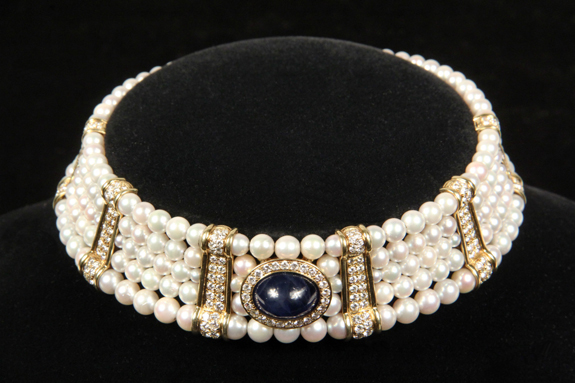
The sale included several pieces of fine jewelry. Bringing the most money was this gold, pearl, diamond and sapphire choker necklace. Comprising five rows of cultured pearls enhanced by a cabochon-cut sapphire surrounded by 24 round diamonds, with additional diamonds on the gold dividers, it brought $29,900.
The text was banned in this country and it was not until 1933 that an American edition was published. Joyce had been unable to get the book published in this country when he finished writing it and had to use a publisher in Paris. Earlier in 1922, the same year that this English edition was published, 1,000 copies were printed by Shakespeare and Company, Paris. Copies of that edition routinely sell for more than $100,000.
Continuing with this general category, the sale included a 1950 letter written by William Faulkner expounding on the motivations for his works. It went to a phone bidder, achieving $6,900.
Veilleux had three very interesting maps, including the first European map of Japan. It was produced by master cartographer Abraham Ortelius in 1592 and was based on a manuscript map by the official Portuguese chart maker Luis Teixeira. Very little was known about east Asia at the time and Korea was shown as an island on this map. It may have been a good buy, going out at $2,990. A 1631 map of the Americas brought only $1,115. It had been produced by Hondius, Henricus, a Dutch cartographer and had inset maps of the North and South poles.
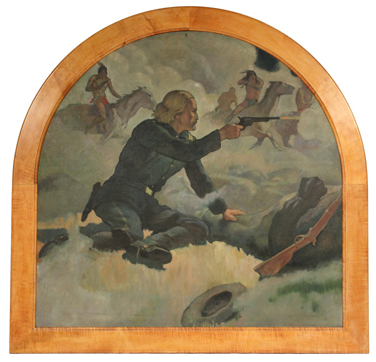
“Custer’s Last Stand” may have been painted by N.C. Wyeth. It was almost identical to an illustration he did in 1932 for a Lucky Strike cigarette ad. It achieved $28,750.
The third map was included with a rare, early Texas book, Atkinson’s Cabinet, Gems of Literature, published in 1836. The folding, hand colored map showed the newly created Republic of Texas and prominently displayed Austin’s colony. The book also included sketches of Mexico and Texas, immediately after Texas won its independence from Mexico. It earned $1,495. A copy on the Internet is offered at $2,500.
There have been countless paintings depicting one version or another of Custer’s Last Stand and there was one in this sale. It was a large oil on canvas, attributed to the Howard Pyle school. It showed Custer with a blazing revolver in one hand, surrounded by, and being shot at, by Native Americans. The scene is almost identical to an N.C. Wyeth illustration commissioned for a Lucky Strike cigarette ad that ran in 1932. The framed painting was 54 by 55 inches and it brought $28,750.
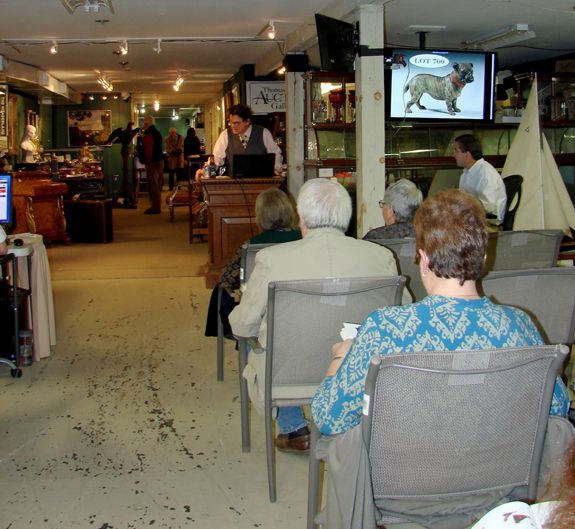
Kaja getting ready to start the sale. There were about 50 buyers in the rooms and several left bids, three Internet platforms working and several phone lines in use.
All in all, the sale included nearly 200 paintings, both American and European. An unsigned Ashcan school painting of the old train yards at Grand Central Station, circa 1905, fetched $5,175. A hunting scene with three setters, “Guarding The Day’s Bag” by John Morris (British, 1865–1924), brought $9,200, while a study of swimmers, attributed to Joaquin Sorolla y Bastida (Spain, 1863–1923) realized the same price. An oil on panel attributed to Edward Hopper (American, 1882–1967) of the Portland Head Light was signed with block letters “EH,” which was a signature Hopper was known to have used in his later life. Hopper spent time at the Ogunquit, Maine, art colony and may have seen the lighthouse during his time there.
Two phone bidders competed with an absentee bidder and the Internet for a painting by Aiden Lassell Ripley (American, 1896–1969). It was a woodland winter scene with several ruffed grouse and it sold well over its estimate, going for $10,350. Leading the European paintings was an untitled abstract work by Friedel Dzubas (German, 1915–1995). It was a color field study in magna acrylic on handmade paper, signed in pencil. His work hangs in the Whitney Museum of American Art, the Guggenheim, the Boston Museum of Fine Arts and numerous other collections. It fetched $18,400.
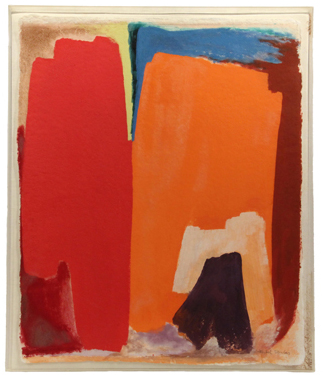
An untitled abstract work by Friedel Dzubas (German, 1915–1995) sold for $18,400 to a phone bidder. It was signed in pencil by the artist and was dated 1979 and 1980 on two labels attached to the rear.
Some furniture was passed and some sold at reasonable prices. A tall case clock by John Doane (1664–1755), Scituate, Mass., went out at $5,175. In a mahogany case, with a molded gable top with a brass finial, a brass and silver dial marked with the maker’s name and a painted ship, it had the original weights, pendulum and crank. A very Victorian gent’s armchair upholstered in wine velvet had large carved gryphon arm supports, a relief carved frieze and square, tapered front legs. A phone bidder — perhaps a gentleman? — took it for $3,162, nearly four times over estimate.
The sale had some pleasant surprises. A 35-piece partial dessert service by Moorcroft in the Pansy pattern finished at $5,750 against an estimate of $1,200. Perhaps the biggest surprise of the day was a Black Forest carved eagle wall-mounted hat rack. It was a very detailed carving of a spread-winged eagle with glass eyes and pronounced beak, claws and feathers. It was 44 inches wide and sold for $17,250, far exceeding its $2,000 high estimate. Four phones were in use and they had competition from the Internet. The online bidder was determined and ultimately successful. Auctions being what they are, a large oak lectern also with a very well carved spread-winged eagle failed to sell.
During the preview, many folks were gathered around the jewelry showcase, examining the offerings and they must have liked what they saw. Selling well over its estimate was an 18K yellow gold choker necklace with five rows of cultured pearls and an oval-shaped sapphire surrounded by 24 rough diamonds. The were six gold dividers with another 168 round diamonds. and it achieved $29,900. A lovely vintage, handmade, 18K yellow gold brooch in the form of a dragonfly drew several bids and wound up at $6,900. It had enamel wings, trace edge set with diamonds and a diamond set body, cabochon emerald eyes and each wing was set with a round blue cabochon sapphire.
Also popular with bidders was a 14K white gold, diamond and multicolor sapphire necklace with 15 heart-shaped drops, each with sapphire surrounded by diamonds. Its final price was $7,475.
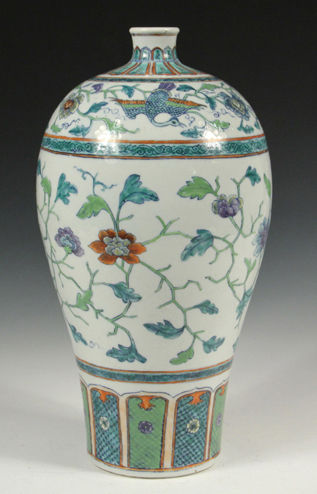
Exceeding its estimate, this 13½-inch Chinese meiping vase from the Daoguang period, 1820–1850, fetched $18,400. Daoguang’s attempts to stop the opium trade resulted in the first Opium War between China and Great Britain, 1839–1842. It did not go well for China.
Several lots of glass did well. A hotly contested Lalique hood ornament for a Rolls-Royce, in the form of a falcon, reached $5,175. It was inscribed “Made for John de Campi” and had been designed by Charles G. Tobin. A Lalique “Perruches Coupe” center bowl with parrot earned $1,552. A large 19-inch Galle long-stem vase with brown trees and a distant green tree line fetched $2,760. It had come in on a free appraisal day, which the gallery conducts each Tuesday.
One of four Tiffany lamps in the sale, a bronze table lamp with a signed Acorn pattern leaded shade sold for $9,200 to an online bidder, while a signed boudoir lamp with a green Favrile Damascene pattern shade went to a phone bidder for $4,025.
Veilleux’s sales generally include a number of unusual items. A large architectural carving of a basket of flowers attributed to Grinling Gibbons, a master woodcarver of the late Seventeenth Century–early Eighteenth Century, brought $8,361. Gibbons worked on Windsor Castle, Hampton Court, St Paul’s Cathedral, Trinity College and other major buildings of the period. Examples of his work are not often seen at auction.
A Wurlitzer-Starke concert harp, circa 1925, sold for $6,325 and there was a trade sign that one would think might be a challenge to use. It was for the “Full Gospel Mission,” circa 1920, but it was more than 20 feet long. An Internet bidder paid $460 for it and hopefully does not have to have it shipped. One could have had the same thought as a 1928 Steinway baby grand piano sold to an Internet bidder for $8,625. Later, Veilleux said that it was going to an island off the Maine coast. Shipping, he said, would be $1,000.
After the sale, Veilleux said that he was competing with 38 other auctions on the same day. “And I think the Paris attacks hurt us. Some people stayed home. But when you have something unusual, like the eagle hat rack, you get the bidders. Overall, I was pleased with the sale. We grossed about $1.4 million and that was okay. I was especially pleased with the snuff bottle collection. It was good stuff and fairly estimated. It all sold. We’re already in discussions about another good snuff bottle collection.”
All prices reported include the buyer’s premiums.
For additional information, www.thomastonauction.com or 207-354-8141.

